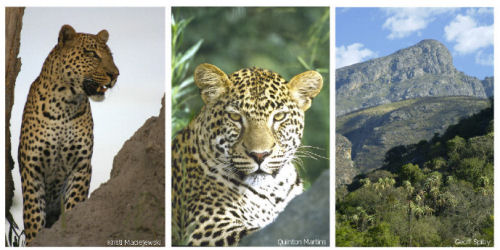Leopard-stock farming interaction in the Baviaanskloof Mega-Reserve

PROJECT TITLE: Socio-Economic and Ecological Correlates of the Leopard-Stock Farmer Conflict in the Baviaanskloof Mega-Reserve, Eastern Cape.
The leopard Panthera pardus, a top predator and one of Africa’s “Big Five” game species, is particularly threatened outside of the large formal conservation areas in South Africa. It has been aggressively excluded from large areas of South Africa through conflict with stock farmers.
There is a long history of conflict between stock farmers and conservation authorities, around the issue of leopards as predators of small-stock in the Baviaanskloof area. There is also a poor understanding of the nature and extent of the leopard-stock interactions.
This project addresses several key questions:
Quantifies the spatial and temporal use of the landscape by the leopards based on incidents of leopard-stock conflicts, derived from records and interviews with conservation staff, landowners and farm workers.
Quantifies the small-stock farmers’ perceptions of the leopard-stock conflicts and relates this to their socio-economic status.
Synthesizes the available data on leopard mortalities through leopard-stock conflicts, and assess the implications of this for the future of the Baviaanskloof leopard population.
Establishes a preliminary profile of the biology and ecology of the BMR leopards, relying mainly on data and material collected in a participatory fashion.
Influences attitudes of landowners and farm workers towards leopards using participatory methods.
The assessment of predator and livestock management techniques.
An estimation of leopard abundance in the Baviaanskloof Nature Reserve using a prey-biomass model.
Distribution and conservation status:
Leopards occur from the southern parts of Africa through the Middle East to the Far East, and their range extends north as far as Siberia and south as far as Sri Lanka and Malaysia (Mills 2005). Globally, leopards are not considered to be threatened with extinction, but are classified on the IUCN Red List as a Near Threatened (Breitenmoser et al. 2008).
In a South African context, the two largest leopard populations occur within the Kruger National Park and the surrounding areas and the Kalahari Gemsbok National Park. In the Cape Province, they occupy the Cape Fold Mountains and forests of the south and south-western Cape (Stuart 1981). There is no exact estimate of the population size for the CFM leopards, but it is considered very small and extremely insecure.
Although leopards are not considered endangered in a global context, nationally they are considered to be threatened with extinction in the medium term future by the National Environmental Management and Biodiversity Act of 2004.
Major threats:
According to Graham et al. (2005), livestock depredation by carnivores is one of the main reasons for conflict between carnivores and humans. Several factors play a role in human-carnivore conflict and combine to create a unique situation where carnivores compete with livestock farmers for the same resources.
In general, farmers that farm next to protected areas (eg Baviaanskloof Mega-Reserve) generally have the greatest depredation rates. In areas where livestock farming is the predominant landuse, carnivore populations will suffer most from direct persecution due to retaliatory actions by the farmers (Mazzolli et al. 2002). This depredation of livestock by carnivores is exacerbated by habitat destruction and the reduction in natural prey, which forces carnivores to prey on domestic livestock (Mizutani 1993). The conflict arises because carnivores are adapted to take ungulate prey and therefore they will take domestic ungulates when the opportunity arises (Treves & Karanath 2003).
For whichever reason, the fact remains that carnivores prey on domestic livestock. According to Treves and Karanath (2003), there is an increase in the frequency and economic cost of the conflict between humans and carnivores in many areas. These perceived economic losses lead to carnivore persecution by farmers (Graham et al. 2005). This effect has lead to the extinction of several carnivore species worldwide (Woodroffe et al. 2005).
FOR FULL TEXT, SEE CHAPTERS BELOW:
Chapter 1: Introduction
Chapter 2: The Baviaanskloof Mega-Reserve
Chapter 3: Ecological correlates of leopard-stock interactions in the Baviaanskloof Mega-Reserve
Chapter 4: Socio-economic correlates and management of leopard-stock farmer interactions in the Baviaanskloof Mega-Reserve
Chapter 5: Modelling leopard abundance: What can we learn?
Chapter 6: General Discussion
View Leopard poster
View project flyer (English)
View project flyer (Afrikaans)
PROJECT FUNDERS: Table Mountain Fund, WWF SA; Nelson Mandela University, ACE, Mazda Wildlife Fund
PROJECT SUPPORTERS: Baviaanskloof Farmers Association; Zuuranys Farmers Association; Cockscomb Farmers Association; Steytlerville Farmers Association; Willowmore Farmers Association; Winterhoek Farmers Association; Friends Of the Baviaanskloof Wilderness Area (FOBWA); Eastern Cape Parks; Department of Economic Development and Environmental Affairs; Agri Eastern Cape; Baviaanskloof Mega-Reserve; Wilderness Foundation
For more information, contact: ace@mandela.ac.za or call 041 504 2316